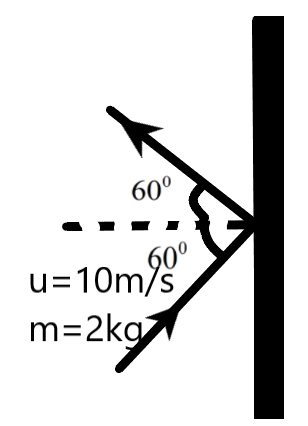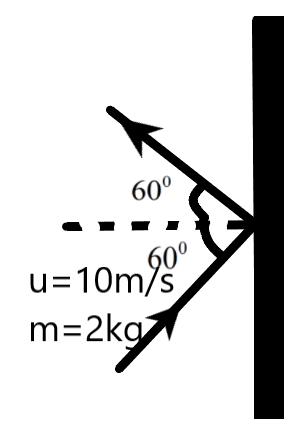Answer
416.7k+ views
Hint: We need to understand the relation between the impulse imparted on an object due to collision with the mass and velocity of the colliding body. We can introduce the law of conservation of linear momentum to find this relation more easily.
Complete step-by-step answer:
The impulse imparted on a body is defined as the force experienced by a body under collision for the time interval of collision. It is given as –
\[\text{Impulse, }I=F.\Delta t\]
We know that the impulse imparted can also be related to the linear momenta of the object before and after collision. The impulse imparted on the object which was collided by another object is defined as the change in linear momentum of the body which collides before and after collision.
\[I={{m}_{1}}{{v}_{1}}-{{m}_{2}}{{v}_{2}}\]
We know that according to the conservation of linear momentum, in a perfectly elastic collision, the magnitude of the momentum before and after collision remains the same. But, the direction of the momentum changes.
Let us consider the situation given to us.

A ball is hitting a wall on which a certain impulse is imparted. We know that the angle of incidence of the ball and the angle of rebounding will be equal in a perfectly elastic collision. We can find the velocity along the x-axis using the cosine function.
\[\begin{align}
& \text{given,} \\
& \theta ={{60}^{0}} \\
& {{v}_{1}}=u\cos \theta \\
& \Rightarrow {{v}_{1}}=10\cos ({{60}^{0}}) \\
& \therefore {{v}_{1}}=5m{{s}^{-1}} \\
& \text{similarly,} \\
& {{v}_{2}}=u\cos \theta \\
& \Rightarrow {{v}_{2}}=10\cos ({{60}^{0}}) \\
& \therefore {{v}_{2}}=5m{{s}^{-1}} \\
\end{align}\]
Now, we can find the impulse imparted on the wall by the ball. The direction of velocity along the x-axis is in the opposite direction for incidence and the rebound condition.
i.e.,
\[\begin{align}
& I={{m}_{1}}{{v}_{1}}-{{m}_{2}}{{v}_{2}} \\
& \Rightarrow I=2kg(5m{{s}^{-1}})\widehat{i}-2kg(-5m{{s}^{-1}})\widehat{i} \\
& \therefore I=+20\widehat{i}kgm{{s}^{-1}} \\
\end{align}\]
The impulse imparted on the wall is along the positive x-axis with a magnitude of 20\[kgm{{s}^{-1}}\].
This is the required solution.
Note: The impulse imparted on the wall during the time of collision is the reason for the change in direction of the colliding ball. The magnitude of the momentum before and after collision can be conserved, but the direction change is contributed by the impulse.
Complete step-by-step answer:
The impulse imparted on a body is defined as the force experienced by a body under collision for the time interval of collision. It is given as –
\[\text{Impulse, }I=F.\Delta t\]
We know that the impulse imparted can also be related to the linear momenta of the object before and after collision. The impulse imparted on the object which was collided by another object is defined as the change in linear momentum of the body which collides before and after collision.
\[I={{m}_{1}}{{v}_{1}}-{{m}_{2}}{{v}_{2}}\]
We know that according to the conservation of linear momentum, in a perfectly elastic collision, the magnitude of the momentum before and after collision remains the same. But, the direction of the momentum changes.
Let us consider the situation given to us.

A ball is hitting a wall on which a certain impulse is imparted. We know that the angle of incidence of the ball and the angle of rebounding will be equal in a perfectly elastic collision. We can find the velocity along the x-axis using the cosine function.
\[\begin{align}
& \text{given,} \\
& \theta ={{60}^{0}} \\
& {{v}_{1}}=u\cos \theta \\
& \Rightarrow {{v}_{1}}=10\cos ({{60}^{0}}) \\
& \therefore {{v}_{1}}=5m{{s}^{-1}} \\
& \text{similarly,} \\
& {{v}_{2}}=u\cos \theta \\
& \Rightarrow {{v}_{2}}=10\cos ({{60}^{0}}) \\
& \therefore {{v}_{2}}=5m{{s}^{-1}} \\
\end{align}\]
Now, we can find the impulse imparted on the wall by the ball. The direction of velocity along the x-axis is in the opposite direction for incidence and the rebound condition.
i.e.,
\[\begin{align}
& I={{m}_{1}}{{v}_{1}}-{{m}_{2}}{{v}_{2}} \\
& \Rightarrow I=2kg(5m{{s}^{-1}})\widehat{i}-2kg(-5m{{s}^{-1}})\widehat{i} \\
& \therefore I=+20\widehat{i}kgm{{s}^{-1}} \\
\end{align}\]
The impulse imparted on the wall is along the positive x-axis with a magnitude of 20\[kgm{{s}^{-1}}\].
This is the required solution.
Note: The impulse imparted on the wall during the time of collision is the reason for the change in direction of the colliding ball. The magnitude of the momentum before and after collision can be conserved, but the direction change is contributed by the impulse.
Recently Updated Pages
Mark and label the given geoinformation on the outline class 11 social science CBSE

When people say No pun intended what does that mea class 8 english CBSE

Name the states which share their boundary with Indias class 9 social science CBSE

Give an account of the Northern Plains of India class 9 social science CBSE

Change the following sentences into negative and interrogative class 10 english CBSE

Advantages and disadvantages of science

Trending doubts
Bimbisara was the founder of dynasty A Nanda B Haryanka class 6 social science CBSE

Which are the Top 10 Largest Countries of the World?

Difference between Prokaryotic cell and Eukaryotic class 11 biology CBSE

Differentiate between homogeneous and heterogeneous class 12 chemistry CBSE

10 examples of evaporation in daily life with explanations

Fill the blanks with the suitable prepositions 1 The class 9 english CBSE

Give 10 examples for herbs , shrubs , climbers , creepers

How do you graph the function fx 4x class 9 maths CBSE

Difference Between Plant Cell and Animal Cell




